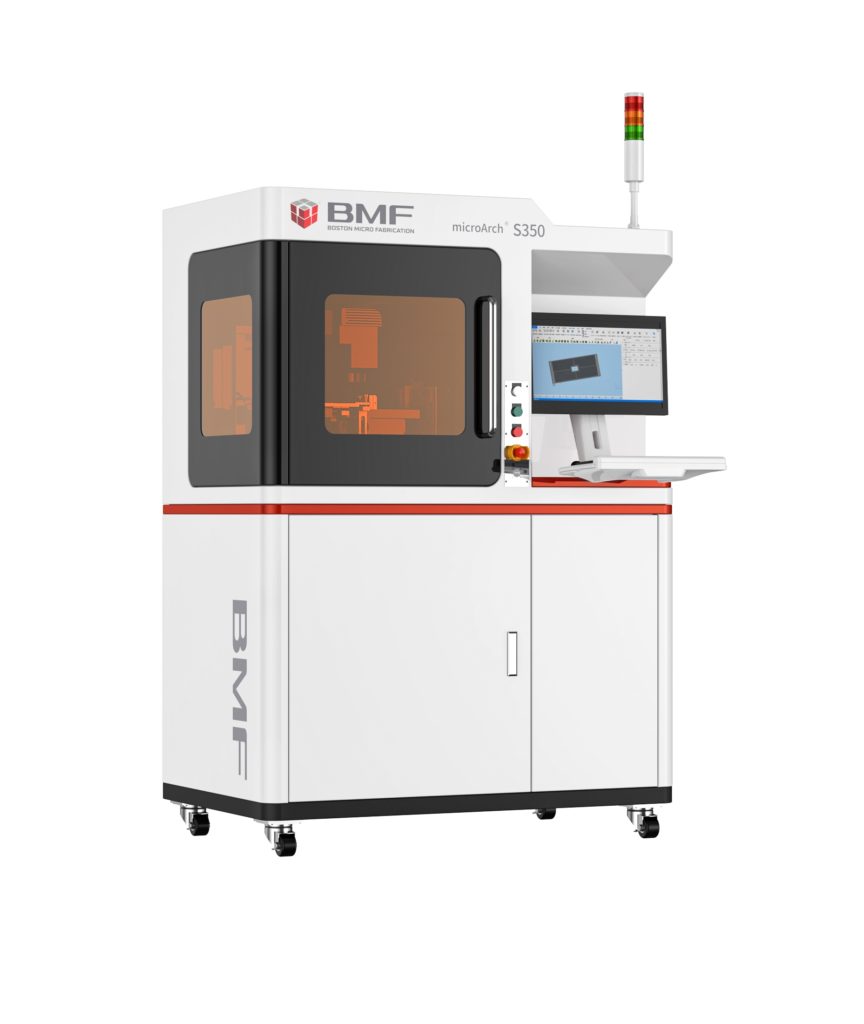Boston Micro Fabrication (BMF), an original equipment manufacturer (OEM) that specializes in microscale additive manufacturing (AM) platforms, announced its latest system today, the microArch S350. BMF is touting the machine as the “highest throughput” printer on the market for micro-precision applications.
As with the company’s previous releases in the microArch series, the S350 utilizes BMF’s patented Projection Micro Stereolithography (PμSL) technology. The S350 is designed for applications for the 25μm scale, like the microArch P150. BMF’s other six printers in the microArch line are for applications requiring 2 and 10 micrometer (μm) resolution.

A μm is 1/1000 of a millimeter, or 1,000 times larger than a nanometer (nm). Thus, 25μm is on the large end of the spectrum for micro-printing applications. Along with the printer’s increased build volume compared to all of the other models in microArch series aside from the S240, the larger resolution size of the S350 (as with the P150) makes it optimal for small parts requiring high accuracy, in addition to micro-scale components.
The S350 also has a new automated lateral membrane shift that, according to the company’s press release, is one of the main sources of the uniquely high throughput for its class. The feature allows for easier part removal, or the ability to integrate the part with a robotic arm. Other new features on the machine that account for both increased throughput and automation include an “advanced roller”, which spreads layers more quickly, automated resin fill and adjustment, and a laser displacement sensor.

Finally, among the wide range of polymers and ceramics the S350 is compatible with, the platform works with two new materials also announced today. One of the resins, BMF MED, was produced by 3D Systems for the company: an amber material optimal for translucent and/or biocompatible end-use products. The other, Loctite 3D 3955, is a high-performance, halogen-free resin.
In terms of what uses the S350 is most ideally-suited for, out of all of the sectors in BMF’s customer base, microfluidics most immediately jumps to mind, and specifically, lab-on-chip applications. The indispensability to the pandemic-era workforce of making rapid at-home COVID tests cheaply and easily available, is just the most obvious example of why a high-throughput, larger build-volume device would be in demand in the micro-printer market.
Beyond that, it is worth emphasizing the fact that small electronics devices — specifically, smart phones — seem to be exactly the right size for the S350. This isn’t to say that commercially-available phones are going to be printed in the near future. But the demand for a platform like BMF’s latest model does at least suggest that prototyping for serial production of 3D printed electronics devices must be getting more and more realistic everyday.
The nature of the arms race between the US and China that the AM market is entangled in makes it easy to focus on the output of larger and larger printed components. Yet, smaller printed components clearly already have a serious edge in terms of their use in commercially-available end-products. It would take even more supply chain chaos than has already been the norm in recent years for the world to get to the point where on-demand printing of electronics devices would become a feasible and plausible alternative. Technologically, however, it seems increasingly realistic to think that the feat could be accomplished if it had to be.
Images courtesy of BMF
Subscribe to Our Email Newsletter
Stay up-to-date on all the latest news from the 3D printing industry and receive information and offers from third party vendors.
You May Also Like
Gorilla Sports GE’s First 3D Printed Titanium Cast
How do you help a gorilla with a broken arm? Sounds like the start of a bad joke a zookeeper might tell, but it’s an actual dilemma recently faced by...
Nylon 3D Printed Parts Made More Functional with Coatings & Colors
Parts 3D printed from polyamide (PA, Nylon) 12 using powder bed fusion (PBF) are a mainstay in the additive manufacturing (AM) industry. While post-finishing processes have improved the porosity of...
$25M to Back Sintavia’s Largest Expansion of Metal 3D Printing Capacity Since 2019
Sintavia, the digital manufacturing company specializing in mission-critical parts for strategic sectors, announced a $25 million investment to increase its production capacity, the largest expansion to its operations since 2019....
Velo3D Initiates Public Offering in a Bid to Strengthen Financial Foundations and Drive Future Growth
Velo3D (NYSE: VLD) has been among a number of publicly traded 3D printing firms that have attempted to weather the current macroeconomic climate. After posting a challenging financial report for 2023,...































